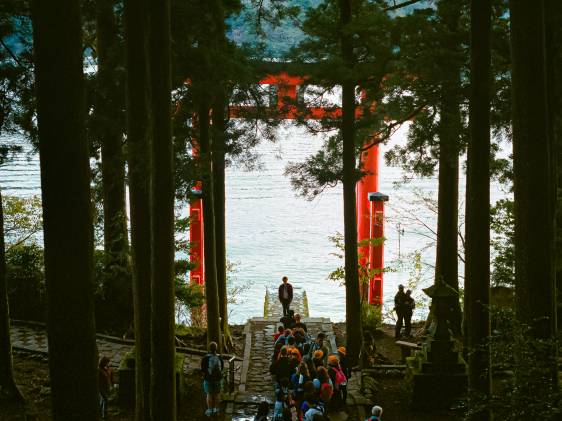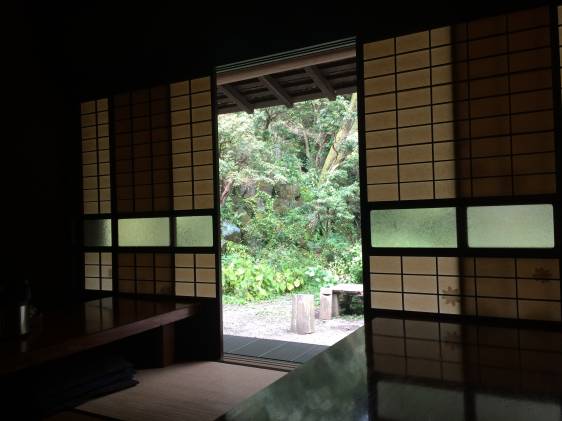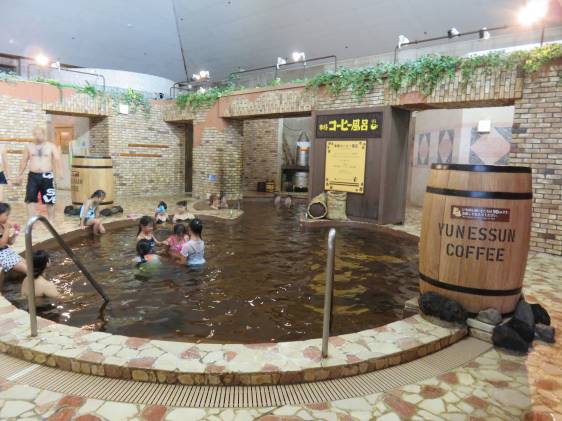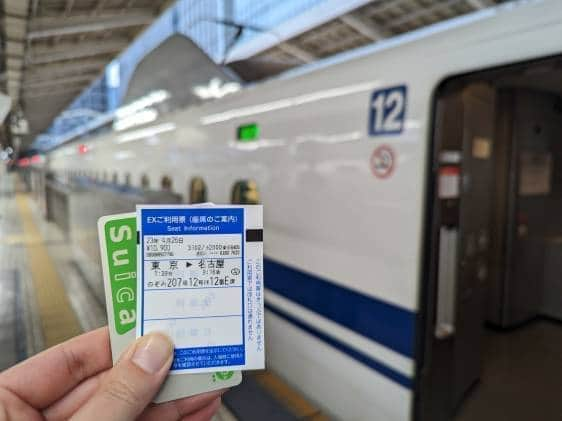There’s plenty to do in Hakone. Take a dip in a hot spring, head to the mountains, walk around a stunning lake, and take in the views of Mt. Fuji.
Hakone also has volcanic scenery, hiking trails, art museums, pirate ships, and bountiful history. And if you’re an Evangelion fan, there’s probably no need to tell you there’s plenty to see from the anime. Really, there’s no end to what you can do, whether you are going for a day, a weekend, or longer. Here are a few pro tips on how to get the most out of your getaway from Tokyo — of course, while keeping that budget nice and low.
How to get to Hakone
Hakone-Yumoto is the main gateway to Hakone and is a jumping-off point for most of the main sights. If you’re getting to Hakone by train (as most people do), you’ll arrive at Hakone-Yumoto Station.

There are lovely hot springs and a couple of shrines to see in Hakone-Yumoto itself; however, most visitors travel further, heading either to Gōra, a town in the mountains, or Lake Ashi, a crater lake with stunning views of Mount Fuji.
While you can do both on a day trip, we recommend not burning yourself out and staying overnight instead. After all, Hakone is a place people go to relax.
Pro tip: The Hakone Free Pass (HFP) is almost always a good deal. It gives you unlimited rides on Hakone area transport, plus small discounts to some popular attractions, and you can buy it from Klook or Headout.
Read about all the different ways of getting to Hakone from Tokyo.
Hakone Free Pass
If you opt to go on your own, we recommend getting the Hakone Free Pass from Headout or Klook. This useful 2 or 3-day transport voucher gives you free access to many methods of transportation around Hakone, including the funicular railway, most buses, the ropeway, and the sightseeing pirate ship that sails across Lake Ashi.
The full pass also covers round-trip travel from Tokyo (usually Shinjuku Station) to Hakone-Yumoto Station via the Odakyu Line. However, if you want to take the special limited express Romancecar train, you’ll need to buy a separate limited express ticket for ¥1,200 (¥1,150 if bought online) each way.
Hakone tours and deals
There are many ways to enjoy Hakone, and you’ll find a range of package deals on offer for Cheapo travelers.
Mt Fuji and Hakone Day Trip
One of the most popular packages is an all-inclusive sightseeing day trip from Tokyo that takes you to both Mt Fuji and Hakone.
You can take a bus tour with Klook — this costs ¥12,980. However, Viator also offers a similar itinerary, but you can ride the Shinkansen back to Tokyo.
If those are sold out, there’s two more “bus out, bullet train back” itineraries we suggest, one on Viator which includes a trip to the boiling sulfurous Owakudani Valley and a similar Mt Fuji and Lake Ashi option with JTB Sunrise Tours (¥24,500). The exact itinerary varies between providers.
Private guide
If you fancy having someone take you around, there are plenty of private guide options. This highly rated 6-hour private guide service costs ¥24,000 per person. You’ll need to make your own way to Hakone though, and the price only includes the guide — so you’ll probably want to pick up the Hakone Free Pass as well.
Outdoor adventures
If you like a bit of exercise and a good view, check out this relatively easy hiking tour of Hakone. The hike has an altitude gain of about 500 meters, includes lunch at a Japanese restaurant, and hot spring at the end.
There are also a number of mountain biking tours of the Hakone and Mount Fuji area.
Lake Ashi: Mt. Fuji views and more

Lake Ashi is at the southern end of Hakone. We recommend visiting the lake early in the day — for a better chance of seeing a clear panoramic view of Fuji.
Getting to Lake Ashi
From Hakone-Yumoto Station, take the Hakone-machi (H) Line bus from stand No. 2. The top sights can be accessed on foot from H Line bus stops around Lake Ashi.
For reference, it takes about 30 minutes from Hakone-Yumoto Station to the bus stop at Motohakone, the most developed part of Lake Ashi. The bus fare is ¥1,080 — or free with the Hakone Free Pass.
Things to do in Lake Ashi
There’s a lot to do on the southern edge of Lake Ashi. Sights are spread out between the two ports, Hakonemachi-kō and Motohakone-kō.
Hakone Shrine
10-minute walk from Hakone-jinja-iriguchi (Bus Stop No. 150)H Line bus from Hakone-Yumoto Station (30 minutes, ¥1,080 without HFP)
Free
Hakone Shrine draws visitors with its Heiwa no Torii, the red shrine gate that appears to be rising out of the waters of Lake Ashi. It reminds us of Miyajima down in Hiroshima (which is one of Japan’s most famous viewpoints!).
If you plan to get a photo in front of the Hakone gate, we’d ask you to reconsider: there is nearly always a long line leading up to it — and the photo usually comes out under-lit.

The shrine itself has quite a few buildings and is surrounded by tall cedar trees, but the most interesting spot is the gate (and the somewhat hidden vermillion bridge nearby).
Hakone Checkpoint
2-minute walk from Hakone-sekisho-ato (Bus Stop No. 154)H Line bus from Hakone-Yumoto Station (40 minutes, ¥1,080 without HFP)
¥500 (¥400 with HFP)
The Old Tōkaidō Road was once a vital trade route connecting Tokyo and Kyoto. This was during the Edo period (1603–1868) when the route was heavily guarded. Travelers had to pass through several checkpoints, with Hakone being one of the most important ones.
Hakone Sekisho — “sekisho” means “checkpoint” — served as a customs and immigration station, where officials would check travelers’ paperwork and belongings before allowing them to pass. Today, it’s a museum showcasing Edo period customs and traditions.
Parts of the Old Tōkaidō Road still exist, and visitors can walk some of it in Hakone. The closest part of the road to the checkpoint is Cedar Avenue, which gives you a little sample of what to expect on a proper hike.
Children: ¥250
Amazake-chaya: A traditional teahouse
Amazake-chaya (Bus Stop No. 322)K Line bus from Hakone-Yumoto Station (23 minutes, ¥710 without HFP)
Sweets and drinks around ¥500
If you have spare time, it’s worth going to Amazake-chaya. This rustic little teahouse is situated alongside the Old Tōkaidō Road and has served as a pit stop for travelers to the region since before Tokyo was, well, Tokyo. It’s been run by the same family for about 400 hundred years.
A fun way to spend an hour or two is to add a visit to the teahouse on your way to Lake Ashi from Hakone-Yumoto. The bus stop for Amazake-chaya is on the K Line route; it takes about 25 minutes to get there from Hakone-Yumoto.
At the teahouse, enjoy a cup of the warm, sweet, nutritious rice drink known as amazake (it’s not actually tea), together with some homemade mochi (sticky rice cakes).
Then, carry on walking along a preserved section of the Old Tōkaidō Highway to Motohakone. The walk, over cobblestones worn smooth with age, takes about 30 minutes.
For more details on hiking the Old Tōkaidō Highway, see our guide to three stunning hikes in Hakone.
Onshi Hakone Park
1-minute walk from Onshi-kōen-mae (Bus Stop No. 153)H Line bus from Hakone-Yumoto Station (35 minutes, ¥1,080 without HFP)
Free
Onshi Hakone Park is a serene area that isn’t overrun with people like some other spots in Hakone. It features a variety of walking paths, picnic areas, and seasonal flowers, such as cherry blossoms and azaleas. You also shouldn’t miss the view of Mount Fuji from the observation deck.
The park is a short walk from Hakone Checkpoint and Cedar Avenue.
Hakone Sightseeing Cruise
1-minute walk Motohakone-kō (Bus Stop No. OH67)H or K Line bus from Hakone-Yumoto Station (32–35 minutes, ¥1,080 without HFP)
¥1,200 one-way, round-trip ¥2,220 (free with HFPass)
Feel like a buccaneer (or Luffy from the anime One Piece) aboard the Hakone Sightseeing Cruise. You’ll set sail on a golden boat that resembles a pirate ship from Motohakone Port to Tōgendai Port — where you can get the ropeway up to Ōwakudani.
During the trip across Lake Ashi (25 to 30 minutes), visitors can see the beautiful Hakone mountains and the famous torii gate of Hakone Shrine. The cruise is also an excellent way to get a closer look at Mt. Fuji, especially on clear days.

Note: You can also get the ship from Hakonemachi Port — which is closer to Hakone Sekisho — but the circuitous route only goes one way and will take you to Motohakone first before stopping at Tōgendai.
Ōwakudani: The Great Boiling Valley
As the whole Hakone area is a hot-spring hotspot, a visit to Ōwakudani, The Great Boiling Valley (not to be confused with the snow monkey haunt of Jigokudani), is a must-visit on any Hakone tour. Riding a gondola up the mountain, you pass over an ominous, sulfuric landscape that looks like the lair of Smaug.
Getting to Ōwakudani
You can reach Ōwakudani via the J Line bus (or car, though parking is expensive) but most people visit via the Hakone Ropeway, which travels between Tōgendai and Sōunzan. Sōunzan is closer to Gōra, reached via the Hakone Tozan Cable Car.
From Tōgendai, the ropeway takes 30 minutes and costs ¥1,500; from Sōunzan, it’s 15 minutes and ¥1,500. Or with the Hakone Free Pass rides on the Hakone Ropeway are free. There’s no admission price to Ōwakudani.

Things to do in Ōwakudani
Once you reach Ōwakudani, you are invited to try the area’s signature black eggs — hard-boiled eggs that have been cooked in steaming, mineral-laden water. Supposedly they’re lucky and eating them can add years to your life, but mostly it’s the novelty of it, the hellfire and brimstone surroundings, and the distinctive smell that make it worth the trip.

Note: There are various side trails and hiking routes around Ōwakudani, but they are sometimes access-restricted because of noxious volcanic gases. Currently, only the short nature trail loop around Ōwakudani is open but requires advanced reservations (online in Japanese). While the main gondola route generally remains open, people with asthma or other respiratory conditions might want to give Ōwakudani a wide berth.
Gōra: Museums in the mountains
Gōra is up in the mountains, at an elevation of 533 meters (1,749 ft). Take your time with Gōra as there are plenty of museums, activities, and sights to see.

Getting to Gōra
Gōra is closer to Hakone-Yumoto. The Hakone Tozan Train runs between Gōra Station and Hakone-Yumoto Station and takes around 40 minutes. Coming from Hakone-Yumoto, Gōra is the last stop.
It’s deceptively far from Lake Ashi, so you may find yourself overstretched if you plan to do both in a day.
To get to Gōra from Lake Ashi, you can follow the circuitous route via Ōwakudani that involves taking the Hakone Sightseeing Cruise, the Hakone Ropeway, and the Hakone Tozan Cable Car, alighting at the terminus in Gōra. This takes well over an hour, not accounting for time spent in transit or at Ōwakudani.
Things to do in Gōra
If you only have time to see one or two museums, take a look at our personal favorites below. But if you want to take it slow, there are plenty of others to find here and elsewhere around Hakone.
Gōra Park
5-minute walk from Gōra Station¥550 (free with HFP)
Even those without a botanical bent will appreciate this delightful mountainside park. The views across to the steep and sometimes misty mountains make for a great setting in which to appreciate the glasshouses of tropical plants, trees, and shrubbery.
There’s also a traditional teahouse for you to enjoy a cuppa the Japanese way. Gōra Park scores bonus points for being quiet with no lines of tourists, and has free entry with the Hakone Free Pass.
Hakone Open-Air Museum
2-minute walk from Chokoku-no-mori StationHakone Tozan Train from Gōra (2 minutes, ¥160 without HFP)
¥1,600 (¥1,400 with HFP or ¥1,500 with online discount)
There are over a dozen museums in Hakone, but our favorite has to be the Hakone Open-Air Museum. This expansive outdoor sculpture museum on the side of a mountain has lots of fun interactive art and a breathtaking setting.
It showcases over 100 modern and contemporary pieces by renowned artists from all over the world. They often have limited-time exhibitions — just like the shy, giant pink cat we spotted.
Students: ¥1,200
Middle School students: ¥800
Elementary School students: ¥800
Pola Museum of Art
Pola-bijutsukan (Bus Stop No. 439)S Line bus from Gōra Station (15 minutes, ¥310 without HFP)
¥1,800 (¥1,600 with HFP)
The Pola Museum of Art is a beautiful facility with a great collection of Impressionist artists, including Matisse, Monet, and Renoir. The museum’s building is also a work of art in itself, designed by architect Ban Shigeru to blend into the surrounding forest. Its spacious galleries and scenic location make it a popular destination for art lovers and nature enthusiasts alike.
Note: You can go direct from Hakone-Yumoto Station, but there are limited bus departures per day and it takes around 40 minutes on winding roads.
Children: ¥700

Top hot springs in Hakone
Onsen in Hakone are too numerous to count. However, some picks that may be of particular interest to international guests are Yunessun, Hakone Yuryō, and Tenzan.
Staying the night? Don’t miss our full guide to the best onsen hotels in Hakone.
Hakone Kowakien Yunessun
2-minute walk from Yunessun-mae (Bus Stop No. 138)H Line bus from Hakone-Yumoto Station (20 minutes, ¥650 without HFP)
From ¥2,100

Yunessun is a kind of hot spring theme park, with sprawling grounds and baths both inside and out. They have lots of fun baths, including tubs filled with wine, coffee, and herbs (separately, of course), as well as a water slide.
The most important thing to note is that this is a co-ed, swimsuit-wearing onsen. It’s a good choice for those who want to try the hot spring experience but are just too shy to go starkers, or those who want to share the experience with friends or family of different sexes. Read more about Yunessun. For admission, you can buy discounted tickets online.
Hakone Yuryō
16-minute walk from Hakone-Yumoto StationShuttle bus from Hakone-Yumoto Station (3 minutes, free)
From ¥1,600 (¥200–¥300 discount with HFP)
Hakone Yuryō boasts several outdoor and indoor hot spring baths, offering guests the opportunity to relax and rejuvenate in therapeutic waters while taking in the surrounding nature.
There are both public and private baths available. Entry for the public onsen starts at ¥1,600. The private onsen is considerably more expensive, starting at ¥9,400 for two hours, but you can get a discount with the Hakone Free Pass.
There is also an atmospheric restaurant in the facility where you can cook your food over an open hearth.
Tenzan Onsen
2-minute walk from Okuyumoto-iriguchi bus stopFree shuttle or K Line bus from Hakone-Yumoto Station (6 minutes, ¥240 without HFP)
¥1,450
Tenzan is a standard hot spring, with beautiful rock-lined rotenburo (open-air baths) against the mountainside. The onsen offers a free shuttle bus from Hakone-Yumoto Station, but what makes this spa notable is its acceptance of tattoos, somewhat rare in the world of Japanese baths. The official policy is that inked patrons aren’t exactly welcomed — guidelines say you need to come alone — but you won’t exactly be booted out, either. Just be discreet, and you should be fine.
Children: ¥700

FAQs: What is Hakone known for and more
What is Hakone famous for?
Most of all, Hakone is known for its hot springs. Onsen are everywhere — in day spas, ryokan, hotels, and foot baths. This is the main reason people visit. That and views of Mt. Fuji from Lake Ashi. If you’re an anime fan, you might also recognize Hakone from Neon Genesis Evangelion.
How many days should I spend in Hakone?
While Hakone can be done in a day, most stay overnight to take in all the areas. Two to three days is enough to see everything, but one day is sufficient if you cut out some sights.
When is the best time to visit Hakone?
Hakone can get very busy, so it is best to visit on a weekday and outside of the fall season when it is extra crowded and hotel prices shoot up.
Late spring is when the ajisai (hydrangeas) bloom alongside the tracks of Hakone’s cute mountain train and winter is preferable because of clear Mt. Fuji views and toasty hot springs.
While on the way to Hakone, why not jump off at Odawara Station and see Odawara Castle?
Looking for more day-trip recommendations? Consider checking out top day-trip destinations like Kawaguchiko and Kamakura.
While we do our best to ensure information is correct, it’s subject to change. This article was first published in January 2015 and has been contributed to by Carey Finn and Chris Kirkland. Last updated in February 2024 by Alexandra Ziminski.
閱讀繁體中文版本: 東京近郊一日遊:玩轉箱根











































